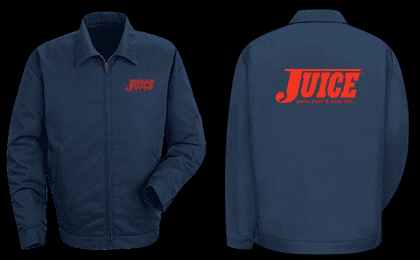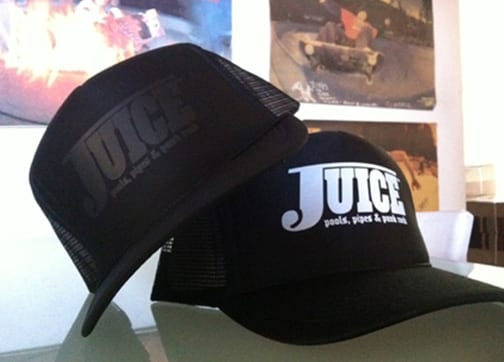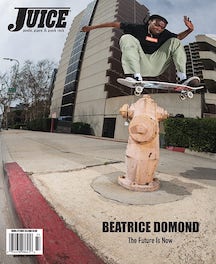SURF SKATE STYLE WITH SHAUN TOMSON. INTERVIEW BY JEFF HO. PHOTO BY TOM SERVAIS.
Shaun, you’ve been a surfing icon.
Thank you, Jeff. [Laughs] You too…
[Laughs] Thanks. You have been a representative of surfing style, for a long time. When did you first hear of SurfSkate style?
You know, it’s interesting. I started skating in 1965, when we were using little wood boards with these little black wheels in South Africa. This was in the longboard era when people would go straight on their boards. There was a little bit of bottom turning, but primarily it was about being like a ballerina. That was kind of the vibe then. You had to look super stylish and artistic, and it wasn’t really about the maneuvers. When we got our skateboards, the skateboard really taught us how to turn and do that transition from one rail to the other, so I learned that from early skate style. That was our own style that we developed down in South Africa. Then surfing transitioned into the shortboard revolution and people became more focused on the maneuvers, as opposed to just how they looked. There was a fusion between the maneuver and how it looked. Then surfing started to influence skate, like how the guys on the North Shore surfing in the ‘70s were influencing guys like Tony and Jay and Stacy and the Dogtown crew. It was interesting. I think I got my first influence in modern surfing from skate and then surf goes back to skate. I’ve never told that to anybody before because I’ve never thought about this before. It’s interesting how that world turned and surf and skate are connected. There is a connection there.
Wow. When you were a young kid, did you start skating first?
No. I surfed first and then I skated and surfed together. Surfing wasn’t really about the carve then. Surfing back then was more about hanging five and hanging ten and drop knee. It was overly stylistic. If there are two extremes with one being the maneuver and one being the style, surfing was way over onto the style side. When we started skating, we really learned to carve from rail to rail. We had this amazing place where we could skate called the Ampitheatre, which had this beautiful round tarmac around this stadium. It was right in front of my house. It’s so funny when I think of it now. We were like 10 or 11 and the cops used to come and chase us and we’d run around the building and run upstairs and hide. It was so fun. I haven’t thought about that for years. I could see there was a connection there. It became so strong with all the Dogtown guys and how they emulated Larry Bertlemann with that low carving style. To me, the absolute essence of surfing is a carve. The Dogtown guys really brought the carve to dry land and it was wonderful. Skateboarding taught me how to carve before surfing did.
Wow. That’s so cool. What does SurfSkate style mean to you?
To me, it’s become representative of something way different to how I saw it originally. When I hear surfskate today, it’s about punk rock. When I think of that fusion of surf skate with how Tony, Stacy and Jay surfed, to me, that wasn’t punk rock. That was art. Today, I find it hard to come to grips with surfskate being punk. To me, it was the antithesis of punk. To me, in my mind, surfskate is art, it ain’t punk. I’m on the other extreme.
I’ve got you on that. It’s become part of our culture and it’s evolved.
Yes. It’s evolved and it’s just changed. How it’s represented now to the masses of skaters is punk. To me, when I started to skate, surfskate was art. Maybe surfskate is punk and skatesurf is art.
Right. Okay, here’s another question. Who has the best SurfSkate style?
Larry Bertlemann, without a doubt, had the best surfskate style. Larry Bertlemann, and Jay Adams in the early days, in the pure days, and Tony Alva, too. You know, Christian also had surfskate style.
Christian had his own thing going on.
You know it’s interesting, when I think of Shaun White, with snowboarding and drawing lines in the snow, he had that integration of rad maneuvers with individual expression and art and imagination. All of these guys were imaginative and they went down their own path. They weren’t emulating anyone else. They were influenced early on by Larry Bertlemann, but they went on their own path, which is something inspirational. It’s always good to see people go down their own path.
For sure. Shaun White is just phenomenal too. You’re right. Okay, how has surfing influenced skateboarding and how has skateboarding influenced surfing?
I think there’s been a massive sharing between both. For me, when I started surfing and I was just learning in the mid ‘60s, skating really helped me with my surfing. I learned to carve instead of just go straight. Skating was what taught me that in South Africa. We were so completely isolated down there, so firstly it taught me to start carving. Then surfing went into skating so heavily in the ‘70s, with surfing as an art form with Larry Bertlemann and Terry Fitzgerald. I think surfing stayed with what Rabbit and myself were doing with our radical maneuvers on the North Shore. I think surfing really had a profound influence on the Z-Boys. Once the Z-Boys found the pools and started to get airs, skating went in such a radical direction. Ultimately, surfing followed that, firstly with Martin Potter and the whole aerial revolution that really started with Martin Potter and Davey Smith, up here in Santa Barbara and on spots on the East Coast. Then you had Christian Fletcher and Matt Archbold. Skateboarding had a really powerful influence on surfing then. For many years, skating became a much more powerful influence on surfing. I’m talking art form to art form. From a cultural perspective, I think, skating had a big influence on surfing, and then there was this cross-pollination of surfing through that whole ‘70s Dogtown era with Stecyk and the advertising and Tony Alva’s advertising and graphics and everything that Craig had done. That had a big influence on surfing. Skating was always more aggro punk while surfing was more about being out in the ocean and freedom. It occupied a different head space. In the late ‘70s and early ‘80s, punk really captured skating. Punk didn’t capture surfing in the same way. I think it’s because of the sensibility. With surfing, you’re just heading out towards the horizons. It’s not about aggro destruction and rebellion. It is, but in a different way. Nature and the openness of the sea, cuts that back, so the two art forms went down different paths. It’s like a river that splits and then merges again and then splits and merges again. That’s how I see the relationship between the two.
I believe that’s true, both culturally and artistically. They’ve both had influences, one on the other, back and forth.
You know. You’ve been in it a lot of years yourself.
Yeah. Okay, here’s one last question. Is SurfSkate style important today?
I think authentic style is important. People must create their own path and I think surfers and skaters definitely do that. It’s fusion too. There is that radical rebellion and art all fused together. That’s what they both represent now. I think it’s really important to listen to your heart and go your own way and be authentic and have a style. Have a style and passion for something, whatever it is. Stand for something. If it’s yours, then stand for it. If it’s yours, it must be authentic. I think it’s as important now for the young guys and girls as it was for all of us guys when we made our mark and first carved our lines in the granite.
That’s the truth. Is there anything else you want to add about surfskate style?
Yeah. There is one other thing that I want to add. I think one of the most important connections between surfing and skating is stoke. The absolute essence of surfskate style is stoke. It’s raw passion, energy and love. To me, that’s what drives me now and that’s what drove me when I first started surfing and skating in 1965. It’s the core of surfskating. It’s that energy, that passion, that love and it’s great that we’ve felt it and that we still feel it. That’s what I love about what I’ve done with my life. I still feel it that strong in my life.
That’s cool. Yeah. It’s for the love and the passion. That’s cool.
Yeah, Jeff. Thanks for thinking of me.

JUICE MAGAZINE SURF SKATE STYLE STORY:
The influence of surfing on skateboarding has been discussed since the beginning of both, yet we have now entered a new era, where skateboarding has returned the favor with its own unique influence on the surfing world. In order to get to the core of this cross over and to try to define the origins and current state and status of surf skate style, we’ve interviewed some of the most innovative skateboarders, surfers, artists, documentarians, photographers, filmmakers and musicians on the planet. In honor of the great, Shogo Kubo, who once said, “To me, style is everything…” welcome to our exploration of Surf Skate Style featuring interviews with Aaron Murray, Aaron Astorga, Abraham Paskowitz, Art Brewer, Bennett Harada, Brad Bowman, Brandon Cruz, Brian Brannon, Carter Slade, Chris Miller, Chris Strople, Christian Fletcher, Christian Hosoi, Craig Stecyk III, Darren Ho, Dave Tourje, David Hackett, Dennis Martinez, Dibi Fletcher, Don Redondo, Eric Britton, Garrett McNamara, Gerry Lopez, Glen E. Friedman, Greg Falk, Greg Galbraith, Greyson Fletcher, Herbie Fletcher, James O’Mahoney, Jef Hartsel, Jeff Ament, Jeff Divine, Jeff Ho, Jim Fitzpatrick, Jim Gray, John Van Hamersveld, Jonathan Paskowitz, Josh “Bagel” Klassman, Kalani David, Keith Morris, Kirra Kehoe, Larry Bertlemann, Laura Thornhill, Lizzie Armanto, Marc Emond, Michael Denicola, Michael Early, Nano Nobrega, Nathan Fletcher, Nathan Florence, Neil Stratton, Norton Wisdom, Pat Bareis, Randy Katen, Ray Flores, Rob Nelson, Robert Trujillo, Scott Oster, Shane Allen, Shaun Tomson, Shota Kubo, Solo Scott, Stacy Peralta, Steve Alba, Steve Olson, Takuji Masuda, Terry Nails, Tim Curran, Tim Hendricks, Tim Kerr, Tom Groholski, Tony Alva, Wes Humpston and Zach Miller.
FOR THE REST OF THE STORY, ORDER ISSUE #75 AT THE JUICE SHOP…
SHARE THIS POST:
- Click to email a link to a friend (Opens in new window)
- Click to share on Tumblr (Opens in new window)
- Click to share on LinkedIn (Opens in new window)
- Click to share on Pinterest (Opens in new window)
- Click to share on Twitter (Opens in new window)
- Click to share on Facebook (Opens in new window)
- Click to share on Reddit (Opens in new window)
- Click to print (Opens in new window)











